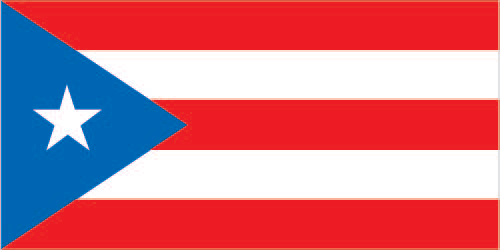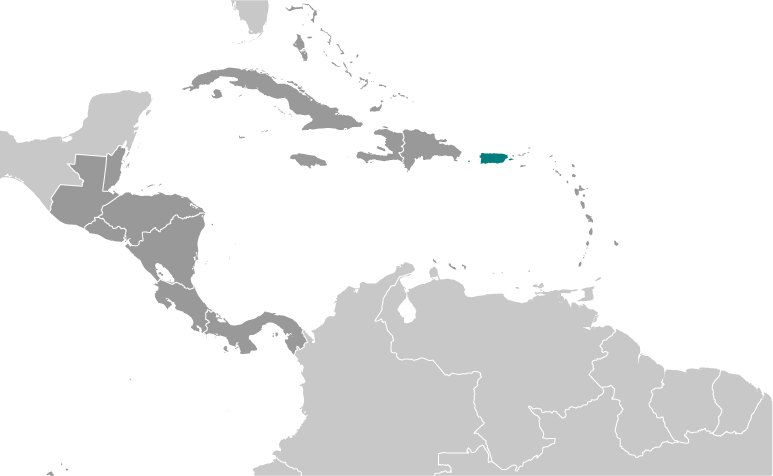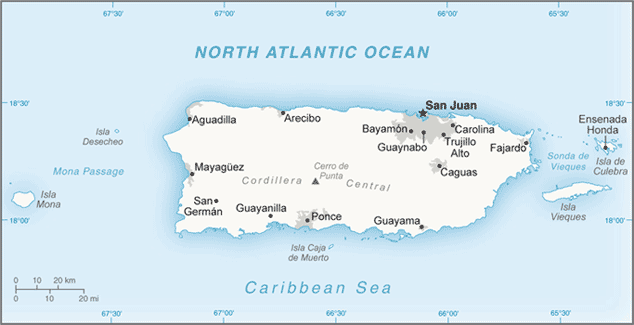



Central America and Caribbean :: PUERTO RICO
Introduction :: PUERTO RICO
-
Populated for centuries by aboriginal peoples, the island was claimed by the Spanish Crown in 1493 following Christopher COLUMBUS' second voyage to the Americas. In 1898, after 400 years of colonial rule that saw the indigenous population nearly exterminated and African slave labor introduced, Puerto Rico was ceded to the US as a result of the Spanish-American War. Puerto Ricans were granted US citizenship in 1917. Popularly elected governors have served since 1948. In 1952, a constitution was enacted providing for internal self government. In plebiscites held in 1967, 1993, and 1998, voters chose not to alter the existing political status with the US, but the results of a 2012 vote left open the possibility of American statehood.
Geography :: PUERTO RICO
-
Caribbean, island between the Caribbean Sea and the North Atlantic Ocean, east of the Dominican Republic18 15 N, 66 30 WCentral America and the Caribbeantotal: 13,791 sq kmland: 8,870 sq kmwater: 4,921 sq kmcountry comparison to the world: 163slightly less than three times the size of Rhode Island0 km501 kmterritorial sea: 12 nmexclusive economic zone: 200 nmtropical marine, mild; little seasonal temperature variationmostly mountains with coastal plain in north; precipitous mountains to the sea on west coast; sandy beaches along most coastal areaslowest point: Caribbean Sea 0 mhighest point: Cerro de Punta 1,338 msome copper and nickel; potential for onshore and offshore oilagricultural land: 22%arable land 6.6%; permanent crops 5.6%; permanent pasture 9.8%forest: 63.2%other: 14.8% (2011 est.)220.4 sq km (2005)periodic droughts; hurricaneserosion; occasional drought causing water shortagesimportant location along the Mona Passage - a key shipping lane to the Panama Canal; San Juan is one of the biggest and best natural harbors in the Caribbean; many small rivers and high central mountains ensure land is well watered; south coast relatively dry; fertile coastal plain belt in north
People and Society :: PUERTO RICO
-
noun: Puerto Rican(s) (US citizens)adjective: Puerto Ricanwhite 75.8%, black/African American 12.4%, other 8.5% (includes American Indian, Alaskan Native, Native Hawaiian, other Pacific Islander, and others), mixed 3.3%note: 99% of the population is Latino (2010 est.)Spanish, EnglishRoman Catholic 85%, Protestant and other 15%3,598,357 (July 2015 est.)country comparison to the world: 1300-14 years: 17.72% (male 325,944/female 311,520)15-24 years: 14.3% (male 263,337/female 251,215)25-54 years: 38.39% (male 661,124/female 720,160)55-64 years: 12.1% (male 197,073/female 238,351)65 years and over: 17.5% (male 271,633/female 358,000) (2015 est.)total dependency ratio: 50%youth dependency ratio: 28.3%elderly dependency ratio: 21.7%potential support ratio: 4.6% (2015 est.)total: 38.7 yearsmale: 36.8 yearsfemale: 40.5 years (2014 est.)-0.6% (2015 est.)country comparison to the world: 22710.86 births/1,000 population (2015 est.)country comparison to the world: 1788.67 deaths/1,000 population (2015 est.)country comparison to the world: 78-8.15 migrant(s)/1,000 population (2015 est.)country comparison to the world: 211urban population: 93.6% of total population (2015)rate of urbanization: -0.21% annual rate of change (2010-15 est.)SAN JUAN (capital) 2.463 million (2015)at birth: 1.02 male(s)/female0-14 years: 1.05 male(s)/female15-24 years: 1.05 male(s)/female25-54 years: 0.92 male(s)/female55-64 years: 0.83 male(s)/female65 years and over: 0.76 male(s)/femaletotal population: 0.92 male(s)/female (2015 est.)total: 7.57 deaths/1,000 live birthsmale: 8.38 deaths/1,000 live birthsfemale: 6.75 deaths/1,000 live births (2015 est.)country comparison to the world: 158total population: 79.25 yearsmale: 75.62 yearsfemale: 82.94 years (2015 est.)country comparison to the world: 481.64 children born/woman (2015 est.)country comparison to the world: 177improved:urban: 93.6% of populationrural: 93.6% of populationtotal: 93.6% of populationunimproved:urban: 6.4% of populationrural: 6.4% of populationtotal: 6.4% of population (2001 est.)improved:urban: 99.3% of populationrural: 99.3% of populationtotal: 99.3% of populationunimproved:urban: 0.7% of populationrural: 0.7% of populationtotal: 0.7% of population (2015 est.)NANANANAdefinition: age 15 and over can read and writetotal population: 93.3%male: 92.8%female: 93.8% (2015 est.)total: 15 yearsmale: 14 yearsfemale: 15 years (2013)total: 26.6%male: 28.9%female: 23.1% (2012 est.)country comparison to the world: 33
Government :: PUERTO RICO
-
conventional long form: Commonwealth of Puerto Ricoconventional short form: Puerto Ricounincorporated, organized territory of the US with commonwealth status; policy relations between Puerto Rico and the US conducted under the jurisdiction of the Office of the Presidentcommonwealthname: San Juangeographic coordinates: 18 28 N, 66 07 Wtime difference: UTC-4 (1 hour ahead of Washington, DC, during Standard Time)none (territory of the US with commonwealth status); there are no first-order administrative divisions as defined by the US Government, but there are 78 municipalities (municipios, singular - municipio) at the second order; Adjuntas, Aguada, Aguadilla, Aguas Buenas, Aibonito, Anasco, Arecibo, Arroyo, Barceloneta, Barranquitas, Bayamon, Cabo Rojo, Caguas, Camuy, Canovanas, Carolina, Catano, Cayey, Ceiba, Ciales, Cidra, Coamo, Comerio, Corozal, Culebra, Dorado, Fajardo, Florida, Guanica, Guayama, Guayanilla, Guaynabo, Gurabo, Hatillo, Hormigueros, Humacao, Isabela, Jayuya, Juana Diaz, Juncos, Lajas, Lares, Las Marias, Las Piedras, Loiza, Luquillo, Manati, Maricao, Maunabo, Mayaguez, Moca, Morovis, Naguabo, Naranjito, Orocovis, Patillas, Penuelas, Ponce, Quebradillas, Rincon, Rio Grande, Sabana Grande, Salinas, San German, San Juan, San Lorenzo, San Sebastian, Santa Isabel, Toa Alta, Toa Baja, Trujillo Alto, Utuado, Vega Alta, Vega Baja, Vieques, Villalba, Yabucoa, Yauconone (territory of the US with commonwealth status)US Independence Day, 4 July (1776); Puerto Rico Constitution Day, 25 July (1952)previous 1900 (Organic Act or Foraker Act); latest ratified 3 March 1952, approved 3 July 1952, effective 25 July 1952; note - constitutional amendments introduced in 2012 were rejected in a referendum (2013)civil law system based on the Spanish civil code and within the framework of the US federal system18 years of age; universal; note - island residents are US citizens but do not vote in US presidential electionschief of state: President Barack H. OBAMA (since 20 January 2009); Vice President Joseph R. BIDEN (since 20 January 2009)head of government: Governor Alejandro GARCIA Padilla (since 2 January 2013)cabinet: Cabinet appointed by governor with the consent of the Legislative Assemblyelections/appointments: president and vice president indirectly elected on the same ballot by an Electoral College of 'electors' chosen from each state; president and vice president serve a 4-year term (eligible for a second term); under the US Constitution, residents of Puerto Rico do not vote in elections for US president and vice president; however, they may vote in Democratic and Republican party presidential primary elections; governor directly elected by simple majority popular vote for a 4-year term (no term limits); election last held on 6 November 2012 (next to be held in November 2016)election results: Alejandro GARCIA Padilla elected governor; percent of vote - Alejandro GARCIA Padilla (Democratic Party) 48.2%, Luis FORTUNO (PNP) 47.1%, other 4.7%description: bicameral Legislative Assembly or Asamblea Legislativa consists of the Senate or Senado (27 seats; 16 members directly elected in multi-seat constituencies by simple majority vote and 11 at-large members directly elected by simple majority vote to serve 4-year terms); the House of Representatives or Camara de Representantes (51 seats; members directly elected in single-seat constituencies by simple majority vote to serve 4-year terms)elections: Senate - last held on 6 November 2012 (next to be held on 8 November 2016); House of Representatives - last held on 6 November 2012 (next to be held on 8 November 2016)election results: Senate - percent of vote by party - NA; seats by party - PPD 18, PNP 8, PIP 1; House of Representatives - percent of vote by party - NA; seats by party - PPD 28, PNP 23note: Puerto Rico directly elects 1 member by simple majority vote to serve a 4-year term as a commissioner to the US House of Representatives; the commissioner can vote when serving on a committee and when the House meets as the Committee of the Whole House, but not when legislation is submitted for a “full floor” House vote; election of commissioner last held on 6 November 2012 (next to be held on 8 November 2016)highest court(s): Supreme Court (consists of the chief justice and 8 associate justices)judge selection and term of office: justices appointed by the governor and confirmed by majority Senate vote; judges serve until compulsory retirement at age 70subordinate courts: Court of Appeals; First Instance Court comprised of superior and municipal courtsnote: the Commonwealth of Puerto Rico Judiciary Act of 2003 reformed the judicial systemNational Democratic Party [Roberto PRATS]National Republican Party of Puerto Rico [Carlos MENDEZ]New Progressive Party or PNP [Pedro PIERLUISI] (pro-US statehood)Popular Democratic Party or PPD [Alejandro Garcia PADILLA] (pro-commonwealth)Puerto Rican Independence Party or PIP [Ruben BERRIOS Martinez] (pro-independence)Boricua Popular Army or EPB (a revolutionary group also known as Los Macheteros)AOSIS (observer), Caricom (observer), Interpol (subbureau), IOC, UNWTO (associate), UPU, WFTU (NGOs)none (territory of the US)none (territory of the US with commonwealth status)five equal horizontal bands of red (top and bottom) alternating with white; a blue isosceles triangle based on the hoist side bears a large, white, five-pointed star in the center; the white star symbolizes Puerto Rico; the three sides of the triangle signify the executive, legislative and judicial parts of the government; blue stands for the sky and the coastal waters; red symbolizes the blood shed by warriors, while white represents liberty, victory, and peacenote: design initially influenced by the US flag, but similar to the Cuban flag, with the colors of the bands and triangle reversedPuerto Rican spindalis (bird), coqui (frog); national colors: red, white, bluename: "La Borinquena" (The Puerto Rican)lyrics/music: Manuel Fernandez JUNCOS/Felix Astol ARTESnote: music adopted 1952, lyrics adopted 1977; the local anthem's name is a reference to the indigenous name of the island, Borinquen; the music was originally composed as a dance in 1867 and gained popularity in the early 20th century; there is some evidence that the music was written by Francisco RAMIREZ; as a commonwealth of the United States, "The Star-Spangled Banner" is official (see United States)
Economy :: PUERTO RICO
-
Puerto Rico had one of the most dynamic economies in the Caribbean region until 2006, however, growth has been negative for each of the last nine years. The down-turn coincided with the phase-out of tax preferences that had led US firms to invest heavily in the Commonwealth since the 1950s, and a steep rise in the price of oil, which generates most of the island's electricity. Diminished job opportunities prompted a sharp rise in outmigration, as many Puerto Ricans sought jobs on the US mainland. Unemployment reached 16% in 2011, but declined to 13.7% in December 2014. US minimum wage laws apply in Puerto Rico, hampering job expansion. Per capita income is about half that of the US mainland. The industrial sector greatly exceeds agriculture as the locus of economic activity and income. Tourism has traditionally been an important source of income with estimated arrivals of more than 3.6 million tourists in 2008. Puerto Rico's merchandise trade surplus is exceptionally strong, with exports nearly 50% greater than imports, and its current account surplus amounts to about 10% of GDP. Closing the budget deficit while restoring economic growth and employment remain the central concerns of the government. The gap between revenues and expenditures narrowed to 0.2% of GDP in 2014, although analysts believe that not all expenditures have been accounted for in the budget and a better accounting of costs would yield an overall deficit of roughly 5% of GDP in 2014. Public debt rose to nearly 94% of GDP in 2014, the equivalent of $15,600 per person, or nearly three times the per capita debt of the State of Connecticut, the highest in the US. Much of that debt was issued by state-run schools and public corporations, including water and electric utilities. In June 2015, Governor Alejandro GARCIA Padilla announced that the island could not pay back at least $73 billion in debt and that it would seek a deal with its creditors.$61.46 billion (2013 est.)$61.83 billion (2012 est.)$63.61 billion (2011 est.)note: data are in 2010 US dollarscountry comparison to the world: 99$61.46 billion (2013 est.)-0.6% (2013 est.)-2.8% (2012 est.)-1.9% (2011 est.)country comparison to the world: 217$28,500 (2013 est.)$28,700 (2012 est.)$29,500 (2011 est.)note: data are in 2010 US dollarscountry comparison to the world: 97household consumption: 89.4%government consumption: 14.7%investment in fixed capital: 13.4%investment in inventories: 1%exports of goods and services: 108.7%imports of goods and services: -127.2%(2014 est.)agriculture: 0.7%industry: 48.5%services: 50.8% (2014 est.)sugarcane, coffee, pineapples, plantains, bananas; livestock products, chickenspharmaceuticals, electronics, apparel, food products, tourism-5.2% (2014 est.)country comparison to the world: 1931.139 million (December 2014 est.)country comparison to the world: 137agriculture: 2.1%industry: 19%services: 79% (2005 est.)13.7% (December 2014 est.)15% (December 2013 est.)country comparison to the world: 151NA%lowest 10%: NA%highest 10%: NA%revenues: $9.033 billionexpenditures: $9.128 billion (2014 est.)14.7% of GDP (2014 est.)country comparison to the world: 207-0.2% of GDP (2014 est.)country comparison to the world: 4293.6% of GDP (2014 est.)91.8% of GDP (2013 est.)country comparison to the world: 191 July - 30 June0.9% (2014 est.)0.9% (2013 est.)country comparison to the world: 543.3% (31 December 2014 est.)3.3% (31 December 2013 est.)country comparison to the world: 171$NA$68.34 billion (2014 est.)$68.27 billion (2013 est.)country comparison to the world: 51chemicals, electronics, apparel, canned tuna, rum, beverage concentrates, medical equipment$46.9 billion (2014 est.)$49.57 billion (2013 est.)country comparison to the world: 57chemicals, machinery and equipment, clothing, food, fish, petroleum products$56.82 billion (31 December 2010 est.)$52.98 billion (31 December 2009 est.)country comparison to the world: 59the US dollar is used
Energy :: PUERTO RICO
-
20.02 billion kWh (2011 est.)country comparison to the world: 7518.61 billion kWh (2011 est.)country comparison to the world: 720 kWh (2013 est.)country comparison to the world: 1890 kWh (2013 est.)country comparison to the world: 1935.571 million kW (2011 est.)country comparison to the world: 7397.2% of total installed capacity (2011 est.)country comparison to the world: 610% of total installed capacity (2011 est.)country comparison to the world: 1702.8% of total installed capacity (2011 est.)country comparison to the world: 1350% of total installed capacity (2011 est.)country comparison to the world: 1180 bbl/day (2013 est.)country comparison to the world: 2100 bbl/day (2010 est.)country comparison to the world: 1730 bbl/day (2010 est.)country comparison to the world: 1130 bbl (1 January 2014 est.)country comparison to the world: 1800 bbl/day (2010 est.)country comparison to the world: 187106,000 bbl/day (2013 est.)country comparison to the world: 740 bbl/day (2010 est.)country comparison to the world: 210176,000 bbl/day (2010 est.)country comparison to the world: 300 cu m (2012 est.)country comparison to the world: 1841.36 billion cu m (2012 est.)country comparison to the world: 840 cu m (2012 est.)country comparison to the world: 1691.36 billion cu m (2012 est.)country comparison to the world: 560 cu m (1 January 2014 est.)country comparison to the world: 18626.81 million Mt (2012 est.)country comparison to the world: 78
Communications :: PUERTO RICO
-
total subscriptions: 820,000subscriptions per 100 inhabitants: 23 (2014 est.)country comparison to the world: 86total: 3.2 millionsubscriptions per 100 inhabitants: 89 (2014 est.)country comparison to the world: 137general assessment: modern system integrated with that of the US by high-capacity submarine cable and Intelsat with high-speed data capabilitydomestic: digital telephone system; mobile-cellular servicesinternational: country code - 1-787, 939; submarine cables provide connectivity to the US, Caribbean, Central and South America; satellite earth station - 1 Intelsat (2011)more than 30 TV stations operating; cable TV subscription services are available; roughly 125 radio stations (2007)AM 74, FM 53, shortwave 0 (2008)34 (2008).prtotal: 2 millionpercent of population: 55.0% (2014 est.)country comparison to the world: 98
Transportation :: PUERTO RICO
-
29 (2013)country comparison to the world: 119total: 17over 3,047 m: 22,438 to 3,047 m: 11,524 to 2,437 m: 2914 to 1,523 m: 7under 914 m: 5 (2013)total: 121,524 to 2,437 m: 1914 to 1,523 m: 1under 914 m:10 (2013)total: 26,862 km (includes 454 km of expressways) (2012)country comparison to the world: 99major seaport(s): Ensenada Honda, Mayaguez, Playa de Guayanilla, Playa de Ponce, San Juancontainer port(s) (TEUs): San Juan (1,484,595)LNG terminal(s) (import): Guayanilla Bay
Military :: PUERTO RICO
-
no regular indigenous military forces; paramilitary National Guard, Police Forcemales age 16-49: 700,443females age 16-49: 786,035 (2010 est.)male: 30,517female: 29,010 (2010 est.)defense is the responsibility of the US
Transnational Issues :: PUERTO RICO
-
increasing numbers of illegal migrants from the Dominican Republic cross the Mona Passage to Puerto Rico each year looking for work
